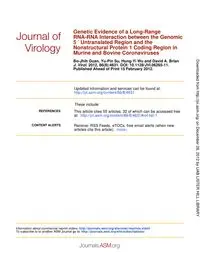
2012 Genetic Evidence of a Long-Range RNA-RNA Interaction between the Genomic 5_ Untranslated Region and the Nonstructur PDF
Preview 2012 Genetic Evidence of a Long-Range RNA-RNA Interaction between the Genomic 5_ Untranslated Region and the Nonstructur
Published Ahead of Print 15 February 2012. 2012, 86(8):4631. DOI: 10.1128/JVI.06265-11. J. Virol. Bo-Jhih Guan, Yu-Pin Su, Hung-Yi Wu and David A. Brian Murine and Bovine Coronaviruses Nonstructural Protein 1 Coding Region in Untranslated Region and the ′ 5 Genomic RNA-RNA Interaction between the Genetic Evidence of a Long-Range http://jvi.asm.org/content/86/8/4631 Updated information and services can be found at: These include: REFERENCES http://jvi.asm.org/content/86/8/4631#ref-list-1 at: This article cites 55 articles, 32 of which can be accessed free CONTENT ALERTS more» articles cite this article), Receive: RSS Feeds, eTOCs, free email alerts (when new http://journals.asm.org/site/misc/reprints.xhtml Information about commercial reprint orders: http://journals.asm.org/site/subscriptions/ To subscribe to to another ASM Journal go to: on December 26, 2012 by UAB LISTER HILL LIBRARY http://jvi.asm.org/ Downloaded from Genetic Evidence of a Long-Range RNA-RNA Interaction between the Genomic 5= Untranslated Region and the Nonstructural Protein 1 Coding Region in Murine and Bovine Coronaviruses Bo-Jhih Guan,a Yu-Pin Su,b Hung-Yi Wu,b* and David A. Briana,b Departments of Microbiologya and Biomedical and Diagnostic Sciences,b University of Tennessee College of Veterinary Medicine, Knoxville, Tennessee, USA Higher-order RNA structures in the 5= untranslated regions (UTRs) of the mouse hepatitis coronavirus (MHV) and bovine coronavirus (BCoV), separate species in the betacoronavirus genus, appear to be largely conserved despite an �36% nucle- otide sequence divergence. In a previous study, each of three 5=-end-proximal cis-acting stem-loop domains in the BCoV genome, I/II, III, and IV, yielded near-wild-type (wt) MHV phenotypes when used by reverse genetics to replace its coun- terpart in the MHV genome. Replacement with the BCoV 32-nucleotide (nt) inter-stem-loop fourth domain between stem- loops III and IV, however, required blind cell passaging for virus recovery. Here, we describe suppressor mutations within the transplanted BCoV 32-nt domain that along with appearance of potential base pairings identify an RNA-RNA interac- tion between this domain and a 32-nt region �200 nt downstream within the nonstructural protein 1 (Nsp1)-coding re- gion. Mfold and phylogenetic covariation patterns among similarly grouped betacoronaviruses support this interaction, as does cotransplantation of the BCoV 5= UTR and its downstream base-pairing domain. Interestingly, cotransplantation of the BCoV 5= UTR and BCoV Nsp1 coding region directly yielded an MHV wt-like phenotype, which demonstrates a cog- nate interaction between these two BCoV regions, which in the MHV genome act in a fully interspecies-compliant manner. Surprisingly, the 30-nt inter-stem-loop domain in the MHV genome can be deleted and viral progeny, although debili- tated, are still produced. These results together identify a previously undescribed long-range RNA-RNA interaction be- tween the 5= UTR and Nsp1 coding region in MHV-like and BCoV-like betacoronaviruses that is cis acting for viral fitness but is not absolutely required for viral replication in cell culture. I n positive-strand RNA viruses that replicate in the cytoplasm, genomic 5=-end-proximal RNA structures carry out several func- tions required for virus reproduction. In coronaviruses, these are thought to include (i) translation initiation, commonly presumed to occur by a canonical cap-dependent 5=-terminal ribosomal entry mechanism, to synthesize the replicase enzymes from open reading frame1(13,14,31);(ii)signalinganRNA-dependentRNApolymer- ase template switch during minus-strand synthesis at a heptameric transcription-regulatory sequence (UCUAAAC in the case of mouse hepatitis coronavirus [MHV] and bovine coronavirus [BCoV]) (Fig. 1A and B) for placement of a common leader on subgenomic mRNAs (sgmRNAs) (43, 48, 49, 55); (iii) encoding signals on the 3= end of minus-strand genomic RNA (the antig- enome) for initiating synthesis of plus-strand genomic mRNAs and sgmRNAs (9, 43, 48, 55); (iv) possibly harboring signals that act in trans to initiate synthesis of nascent plus-strand genomes (46); (v) possibly directly influencing initiation of minus-strand synthesis at the 3= end of the genome (33); and (vi) harboring a genome packaging signal (10, 18). A mechanistic understanding of these events may aid in the development of therapeutic inhibi- tors of coronavirus replication. In a previous study (22), we exploited the �36% nucleotide (nt) sequence divergence between the 5= untranslated regions (UTRs) of BCoV and MHV, separate species in the betacoronavi- rus genus (15) (formerly classified as group 2a coronaviruses), to identify potentially common 5=-end-proximal cis-acting elements for replication of MHV. Despite the relatively high nucleotide sequence divergence, higher-order structures in the 5=-end-prox- imal genomic regions of these two viruses are largely conserved (Fig. 1A and B) (7, 10, 29, 33, 35, 36, 41, 42), although the nomen- clature is not yet uniform, since stem-loops (SLs) II, III, and IV in Fig. 1 are respectively named stem-loops 3, 4 and 5 by the Leibow- itz, Giedroc, and Olsthoorn laboratories (10, 29, 33, 35, 36). It was learned that the BCoV SLI/II domain (nt 1 to 84), which contains higher-order structures named SLI (now known to be comprised of stem-loops 1 and 2) (29, 33, 35, 36) and SLII, can functionally replace its MHV counterpart, as can the SLIII domain (nt 85 to 141) and the SLIV domain (nt 174 to 226). For function, SLIV required a 16-nt extension into the nonstructural protein 1 (Nsp1) coding region to form a “long” SLIV (Fig. 1A and B). In each of these substitutions, despite nucleotide differences of 37, 22, and 33%, respectively, the chimeric virus replicated for at least three passages without compensatory suppressor mutations ap- pearing within the 5=-most 1,000 nt and 3=-most 500 nt of the genome. In contrast, a 30-nt inter-stem-loop domain in the MHV 5= UTR that resides between SLIII and SLIV (nt 141 to 170) could not be replaced by the 32-nt BCoV counterpart (nt 142 to 173) to directly yield viable virus after transfection of the chimeric RNA genome (22). However, the resulting chimera, B142-173/M, pro- duced plaques and viable progeny after two blind cell passages in Received 8 September 2011 Accepted 2 February 2012 Published ahead of print 15 February 2012 Address correspondence to David A. Brian,
